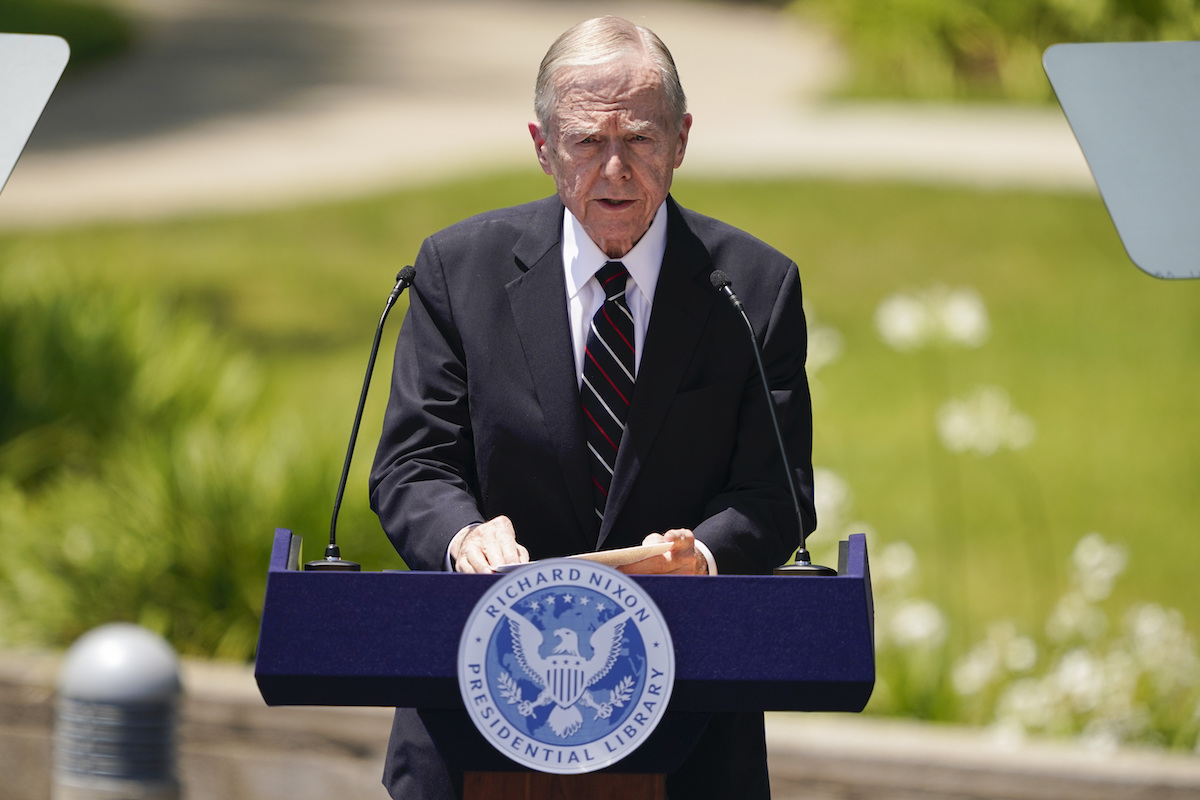

Pete Wilson, former governor of California, introduces Secretary of State Mike Pompeo at the Richard Nixon Presidential Library, Thursday, July 23, 2020, in Yorba Linda, Calif. (AP Photo/Ashley Landis, Pool)
Recently, a statue of former California Governor Pete Wilson was removed from a San Diego park in response to objections that Wilson was a leader of exclusionary politics and policies. While the ultimate fate of the statue is still undetermined, Wilson may be the only living model to have a statue taken down during our nation’s current progressive era of greater recognition and reckoning with the all-too-omnipresent resonances of historical policies and practices of racial oppression.
Although the sculpture’s removal did not stem from Wilson’s very recent public and political re-emergence through his endorsement of Donald Trump —perhaps the most unpopular president in California history— Wilson’s committed opposition to racial inclusion is still fairly recent in historical terms. Indeed, one of his historical legacies is on our California ballot in the form of Proposition 16. A Yes majority on Proposition 16 would remove from the state constitution one of Wilson’s most prominent exclusionary policies—the affirmative action ban enacted as Proposition 209 in 1996.
As governor, Wilson embraced the ban on affirmative action as enthusiastically and tenaciously as he did Proposition 187, the anti-immigrant initiative enacted in 1994 and tethered quite closely to Wilson’s own successful re-election campaign. As explored in a recently-released documentary film, Proposition 187 was a catalyst for increased Latino and progressive engagement in California politics, resulting in our current status as a potent counterweight to Trump’s regressive “Citizens First” politics.
The parallels between Wilson as governor and Trump as president go beyond the anti-immigrant leadership theme. Like Trump, Wilson was tenacious in pressing on measures to punish undocumented immigrants. Also like Trump, Wilson used the courts to pursue his aims. Trump has sued California about its so-called “sanctuary” policies, and he regularly threatens to sue states that disagree openly with his policy predilections. Governor Wilson sued the federal government in the name of the state of California, alleging that the failure to prevent undocumented immigration violated the Invasion Clause of the U.S. Constitution, a provision almost universally interpreted then and now as guaranteeing federal protection against an armed military invasion. Notably, Trump also often uses troublingly militaristic metaphors in speaking about peaceful migrants, including children.
Wilson’s vehemence also extended to his opposition to affirmative action, which he sought to reinforce regularly through rhetoric, policy apparatus, and litigation. Here too, Wilson as precursor of Trump is manifest, with this administration’s current lawsuits attacking affirmative action at Harvard and Yale.
In 1996, Wilson assiduously engineered the placement of Proposition 209 on the ballot, just as he had done two years before with Proposition 187. The initiative effort was led by Ward Connerly, a longtime friend and supporter of Wilson and one of the governor’s appointees to the University of California Board of Regents. Then, Wilson tied the new initiative, as he did with Proposition 187, to his personal political ambition. This time, instead of re-election, he was seeking the Republican presidential nomination. Fortunately, for this purpose, Connerly had begun the anti-affirmative action crusade in mid-1995 by securing the Regents’ passage of two resolutions banning affirmative action at the University of California.
This time, the political strategy fell short, as Wilson had to end his presidential campaign after little more than a month in September 1995. Nonetheless, Wilson remained a zealous foe of equal opportunity programs. Beyond administration policy efforts, he again turned to aggressive action in the courts. This time, Wilson in effect sued himself, acting directly as plaintiff and naming his own appointees as defendants as he sought to strike down statutory equal opportunity programs that he disapproved. The governor suing himself surely marked a pinnacle of California quirkiness, but also amply manifested Wilson’s career-defining commitment to opposing affirmative action.
As these and other parallels demonstrate, the through line connecting the anti-immigrant Proposition 187 and the anti-affirmative-action Proposition 209 is apparent, and it takes human form in the person of chief proponent Governor Pete Wilson.
For many, his championing of the two racially divisive ballot measures is reason enough to remove Wilson’s statue permanently. Propositions 187 and 209 unquestionably divided California racially during an important time of increasing diversity when inspired leadership would have sought to preserve and increase unity. Yet, perhaps even more important than bringing down the physical statue of Wilson is toppling the legal icon of Proposition 209, which remains in the state constitution and continues to act as a barrier to consideration of equal-opportunity policies.
Fortunately, California’s diverse and progressive electorate has the opportunity to overturn that Pete Wilson legacy with a Yes on Proposition 16 this election.
***
Thomas A. Saenz is is President and General Counsel of the Mexican American Legal Defense and Educational Fund (MALDEF). Twitter: @MALDEF.


